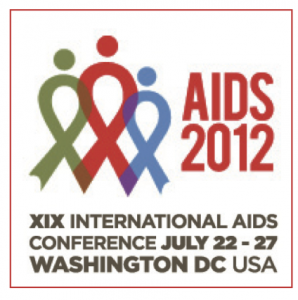Switching to rilpivirine/tenofovir/FTC fixed dose combination from boosted-PI regimen: SPIRIT study draws the line at 24 weeks
1 August 2012. Related: Conference reports, Antiretrovirals, World AIDS 19 Washington 2012.
 Simon Collins, HIV i-Base
Simon Collins, HIV i-Base
Frank Palella from Northwestern University, Chicago, presented results from an international study of 476 patients on stable boosted-PI combinations who were randomised 2:1 to switch to open label rilpivirine/tenofovir/FTC (n=317) or continue on their current treatment (n=159).
Although patients could be on first or second line treatment, they had to be NNRTI-naive, although, inexplicably, detection of the primary NNRTI mutation K103N was allowed. The primary endpoint was viral suppression (<50 copies/mL) at week 24 with non-inferiority defined by a lower margin for the confidence interval of –12%, and follow up for the rilpivirine arm until week 48. Lipid changes were also evaluated.
Baseline characteristics were balanced between arms and included approximate median age 42 (IQR 35-49), 86%-91% male, 75% white, 19% black. Median time since first ART was just under 3 years (IQR 1.7–4.8) and mean CD4 count was around 600 cells/mm3 (SD +/– 237). Approximately 80% of people were taking tenofovir/FTC at baseline with PI use predominantly atazanavir/r (37%), lopinavir/r (33%) and darunavir/r (20%).
At week 24, virologic suppression was similar with 94% vs 90% in the NNRTI vs PI arms (difference 3.8; 95%CI –1.6 to +9.1) remaining suppressed <50 copies/mL. Approximately 5% of patients in each arm had missing data. CD4 increases were also similar (+20 vs +32 cells/mm3 respectively; p=0.28).
Approximately 2% vs 5% of patients were defined as non-suppressors in the NNRTI vs PI arms. This represented three people in the NNRTI arm: one who was <400 copies/mL, one at 410 copies/mL with the M184V mutation and one who rebounded to 11,000 copies/mL and who failed with M184V, V90I, L100I and K103N. This last patient was reported as a protocol violation due to previous use of efavirenz and not meeting the criteria of viral suppression for six months prior to study entry.
The majority of patients with detectable viral load in the PI/r arm (7/8) had viral load between 50 and 400 copies/mL and were likely to be blip results, but one had rebounded to 13,000 with the M184V mutation. Of the patients without 24 week data, three patients in the NNRTI arm switched due to CNS-like side effects (sweats, fatigue, depression, anxiety and insomnia) or renal impairment; and approximately 3% in each arm discontinued for other reasons, but had viral load of <50 copies/mL at the time.
In one of those parallel universe moments (did I really hear this?), it was not very helpful for the presenter to refer to an “intent-to-treat, missing = excluded” analysis as being “a more standard analytic approach” when for at least ten years a “missing = failure” analysis has been emphasised – primarily because near 100% efficacy results are easy to achieve if the data on people for whom the treatment was not effective are excluded. The claim of a significant difference between the two arms when this analysis reported a 99.7% response for the NNRTI arm should fool no one. However, the 17 patients with historical evidence of K103N who were switched to the rilpivirine FDC had maintained viral suppression to week 24.
Grade 3/4 laboratory abnormalities were reported in 6% vs 11% of the NNRTI vs PI groups, mainly creatinine kinase (likely related to rilpivirine) or atazanavir-related increases in bilirubin.
Changes in baseline lipids (mg/dL) all were significantly reduced in the NNRTI vs PI arms: total cholesterol (-25 vs 1), LDL (-16 vs 0), triglycerides (-53 vs +3), HDL (-4 vs -1); all p<001. Changes in the TC:HDL ratio (–0/27 vs + 0.08) also favoured the NNRTI, which also resulted in a statistically significant difference in Framingham risk score.
comment
Although switch data are interesting, week 24 data is a very early time point and it is therefore disappointing that longer durability data will not come from this study: at week 24 all patients are being switched to the rilpivirine FDC, thereby eliminating a control group for the week 48 analysis.
This makes the detail for non-suppressors and missing data patients important as they hint at possible poorer tolerability, and perhaps even virological differences, that do not favour the rilpivirine arm.
Although seen as an alternative to Atripla for people who have side effects to efavirenz, the CNS events are only halved rather than eliminated, and there are important differences between the FDCs that are often not communicated to patients: the rilpivirine-based FDC needs to be taken with a 550 calorie meal; efficacy in naive patients is reduced when baseline viral load is greater than 100,000 copies/mL; and the shorter half life of rilpivirine compared to efavirenz doesn’t support a wide flexibility in dosing time.
The fixed dose combination (FDC) of rilpivirine/tenofovir/FTC was approved last year and is marketed as Complera in the US and Eviplera in Europe.
Reference:
Palella F et al. SPIRIT study: switching to emtricitabine/rilpivirine/tenofovir (FTC/RPV/TDF) single-tablet regimen (STR) from a ritonavir-boosted protease inhibitor and two nucleoside reverse transcriptase inhibitors (NRTIs) maintains HIV suppression and improves serum lipids in HIV-positive subjects. 19th International AIDS Conference. 22-27 July 2012, Washington. Oral Abstract TUAB0104.
http://pag.aids2012.org/Abstracts.aspx?SID=202&AID=643
http://pag.aids2012.org/flash.aspx?pid=1461

